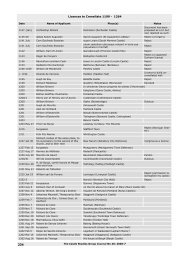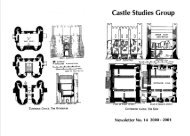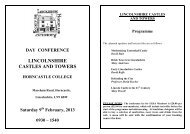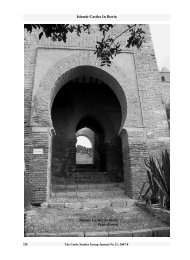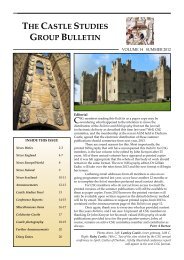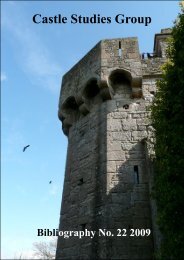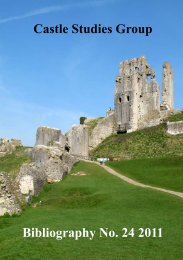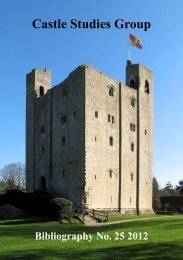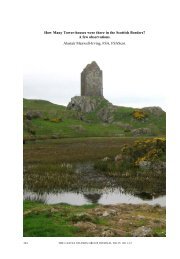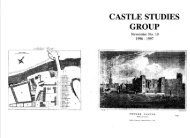Machicolation: some postscripts. - Castle Studies Group
Machicolation: some postscripts. - Castle Studies Group
Machicolation: some postscripts. - Castle Studies Group
Create successful ePaper yourself
Turn your PDF publications into a flip-book with our unique Google optimized e-Paper software.
<strong>Machicolation</strong>: <strong>some</strong> <strong>postscripts</strong>.The villa was built after the marriageof Hieronimo Giustinian to AgnesinaBadoer: a union of two of the wealthiest butalso the oldest families in Venice. They didnot need the trappings of feudal architectureto disguise parvenu status, althoughpossibly the move from Venice to terrafirma did call for the suggestion of longtermland ownership and of being part of along-standing mainland aristocracy; therehad been a castle on the site centuries before.Perhaps the Venetian chimneys showa need not to cut ties with the city. The villahas clearly been restored and has sufferedfrom decay. The merlons of the walls andgatehouse have been rebuilt but the cornertowers lack merlons and most of theirmachicolation brackets have been brokenaway. The present merlons, Ghibelline aswe have seen, are puzzling – the Venetianswere not known for espousing the Imperialcause and the drawing of 1536 seems toshow square merlons. 17 But we can be reasonablysure that no restoration would haveconverted merely token machicolation into“real” machicolation: this was built thisway.There has never been much doubtthat machicolation was used as a symbol ofpower and authority even when circumstancesmade it impracticable to use, northat it changed through full-size but nonfunctionalmachicolation into a merely decorativemotif. One thing that Roncade tellsus is that we cannot be sure that the pace ofthis change corresponded with the abandonmentof mediaeval, pre-gunpowderstyles of military architecture. At Roncade,we are in a world where a client is makingchoices about what his building will sayabout him and apparently enjoying it. Andthis seems to include a joke!End Notes1. CSG Journal 23, 2009-10, p. 191.2. The Journal of British Archaeological AssociationConference Transactions No. VIII. Thearticle is entitled “Ecclesia Pulchra, EcclesiaFortis.” The title derives from Henry of Huntingdonwho had written about the strength ofthe church in “Historia Anglorum” (c.1129-33.) Gem’s article is noted by Pevsner andHarris in “Buildings of England: Lincolnshire.”(It should be stated at this point that thepresent writer is not the John Harris whoco-authored the Pevsner book.) Gem had proposedthe idea in 1978 in a paper presented tothe Society of Antiquaries and in 1984 in theessay “English Romanesque Architecture” inthe catalogue to the exhibition “English RomanesqueArt 1066-1200” at the HaywardGallery. Mediaeval Archaeology 41. The articleis entitled “The Early Norman <strong>Castle</strong> atLincoln and a Re-evaluation of the OriginalWest Tower of Lincoln Cathedral.”3. This piece is immensely interesting in manyways, not least in its study of the use made bythe Normans of Roman fortified sites. Seealso “In Hoc Signo” by Anthony Quiney inArchitectural History Vol. 44 (2000) whichdiscusses the design of the west front as awhole. Quiney suggests there may have beentimber “fighting platforms” spanning the portalsin addition to the machicolation. Onemight think that anyone on the platforms wasat risk from the machicolation above. Remigius(who also appears as Remi) had foughtat Hastings. The tricky questions of militarysymbolism in cathedral architecture and thesignificance of the triple portal entrance areraised in Otto von Simpson “The Gothic Cathedral.”4. Stocker and Vince convincingly argue for thekeep, as has been suggested. There is an argumentthat the decorative frieze on the westfront is part of a conversion of a militarybuilding into a religious one.5. Harris, op cit. p. 193, amongst others. See thearticle by Peter Burton in CSG Journal 22, p.228 et seq., photos 4 and 11.6. Work certainly could be done to place thisstructure in the overall typology of early hallkeeps. See, for instance, the work published in“A Suggested Dual Origin for Keeps” by MW Thompson in Fortress 15, November 1992.7. If we are accept the general idea of thisbuilding being a keep, there may be scope forsuggesting alternatives to these reconstructions.The question of the east wall is difficultto resolve.The <strong>Castle</strong> <strong>Studies</strong> <strong>Group</strong> Journal No 24: 2010-11 226



